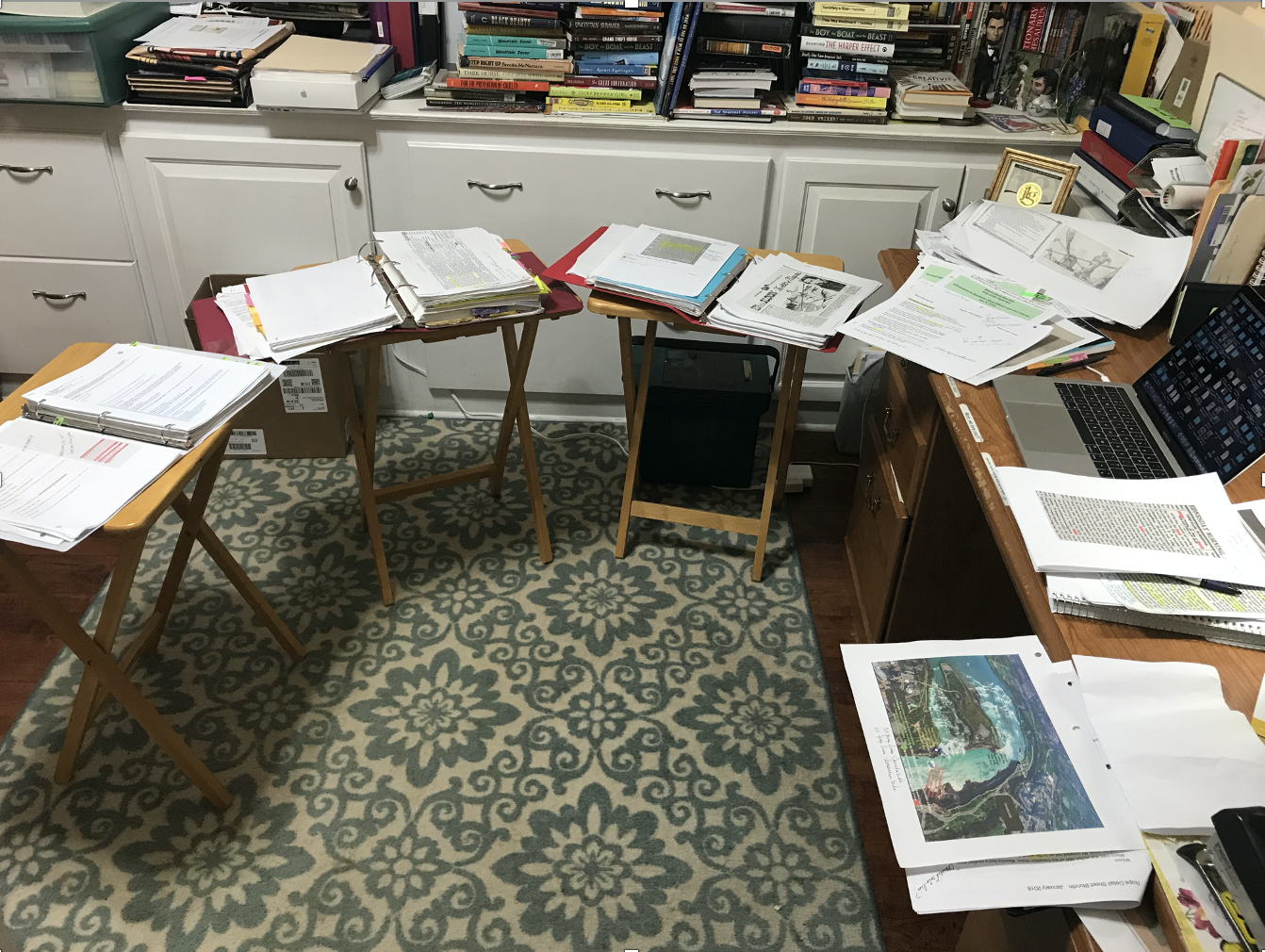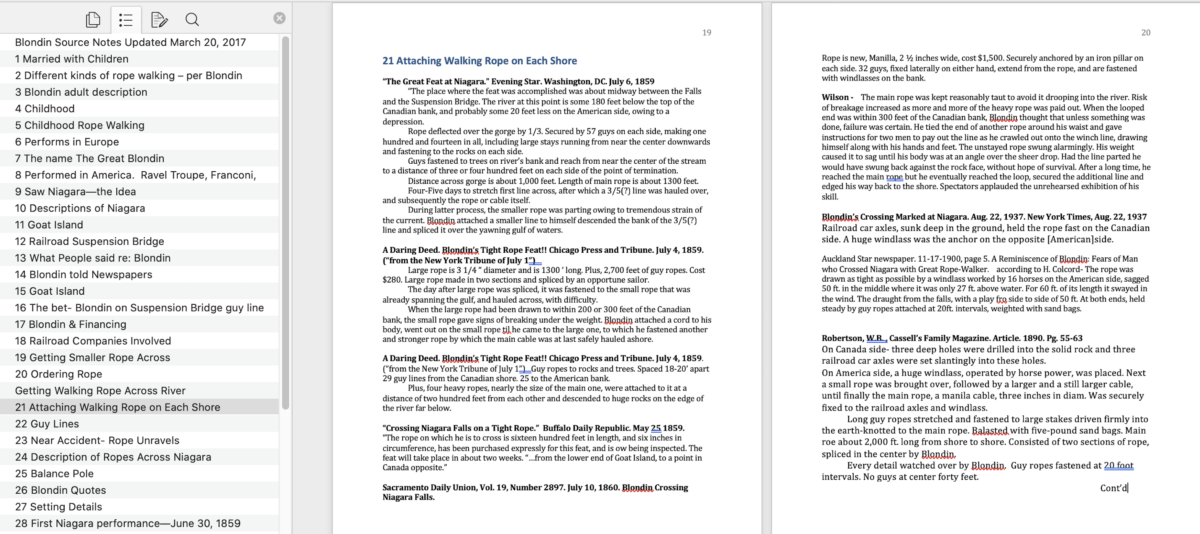
Final fact-checking for King of the Tightrope: When the Great Blondin Ruled Niagara
11/10/22 ADDED NOTE TO PROVE THE VALUE OF ORGANIZED RESEARCH: In 2020, four years after Step Right Up published (even longer than that since I was in active research mode), I was contacted by a Hollywood producer who wanted to chat about the story. And this year, 2022, I have given two interviews to BBC about Doc and Jim. In both cases, I needed to refresh my memory and access my research, but I did not flail through random articles and notes. My binders were 100% organized, and my book bible (below) provided everything I needed in one place.
One of my favorite things about writing nonfiction is research—part scavenger hunt and part archaeological dig into the past. But what’s the best way to organize the resulting mountain of research? It’s a question that always pops up in forums and writers’ groups. The truth is, there is no single right system. Much depends on the topic, the volume and type of materials, and most importantly, each person’s individual style.
Early in my writing career, I flailed my way through index cards, spiral notebooks, file boxes, endless manilla folders. The problem was that, when I needed to find a detail, fact, or quote, it was like searching for the proverbial needle in a haystack. So I pursued a more streamlined process—one that allowed easy access for my immersive writing style and comprehensive research style in a low-tech way. When it comes to my work, I want to be able to find what I’m looking for immediately. For some writers, software programs like Scrivener or Evernote are perfect tools for that goal and their own styles. For others, the spiral notebooks and index cards that make me a little dizzy, are ideal. To each her own! I experimented widely until I settled on a system that works for me. No doubt, my process will evolve over time, but here’s my current 4-step system:
#1—Research like the dickens—beyond the obvious sources
#2—Create digital file folders for thoughtfully-labeled, easily-sharable, digitized or scanned documents, interview transcriptions, etc.
#3—D-ring binders—the perfect adjustable container.
* If the book is topical, I organize the binder by related sub-topics.
* If the book is historical or biography, I organize chronologically, with necessary sub-topic categories, too.
* I print the most reliable sources for the binder.
[rl_gallery id=”8948″]
#4 Create a Book Bible—
* Open a Word document and turn on Navigation Pane or Document Map (usually under the Sidebar option)
* Create category headings using a heading style, which automatically triggers the navigable sidebar, like a table of contents. Clicking on one of the headings jumps the cursor to that section of the document. No more scrolling. Nifty, huh?
* Extract relevant quotes, details, information from the binder sources, books, and interviews, and type them under the appropriate headings, with citations. (Most often, a single source, like a book or newspaper article, has information that fits under multiple categories. For example, a single eyewitness account for King of the Tightrope can include rope information, Blondin’s background, Niagara details, and Blondin’s costume—all of which can be extracted for different category headings. This is especially important when there are conflicting details across sources. It’s much easier to scrutinize disparities when the accounts are in one place.
Creating a book bible is tedious and time-consuming, and the process makes me grouchy. But once completed, I feel empowered and confident. A single book bible (usually 50-100 pages for a picture book) contains the most relevant and important information for my book project in one Word document. When does it come in handy? When it’s time to craft a bibliography; when I need to share a source with my editor; when I’m knee-deep in revision or rewrites and need to quickly find information; if anyone questions the content in my nonfiction narratives. And just imagine how ready I’ll be if Hollywood comes knocking, or if an opportunity related to one of my books arises in the future, when the research is no longer fresh in my memory.
Could I write a nonfiction picture book without researching as deeply and as widely as I do? Probably. Could I wrangle the research without going the extra mile with my binders and my book bibles? Sure, but it would feel like wearing ill-fitting shoes. I know myself and my immersive writing and research style enough to know that condensing and containing information is what I need.
Writer friends, you do you. Whatever your style, however you roll, allow yourself time to flail around until you find what works best for your unique comfort level. In the meantime, I hope you’ll share your own suggestions in the comments.
Happy researching!
[rl_gallery id=”8935″]
Above: Book bibles for Step Right Up (92-page document), Abraham Lincoln’s Dueling Words (54-page document), and King of the Tightrope (49-page document)
Below: A Sample page from my King of the Tightrope book bible, with partial sidebar visible



Donna, I’d love to hear more about your digital files. I keep folders and subfolders but think I could do better.
Also, for your print sources, do you scan each one which has relevant content?
I just shared this post as a resource and challenge in my KidLit-Creatives.teachable.com nonfiction class. It’s so important to see a variety of ways to organize. Your Book Bibles are pretty amazing. I have not done that, but I can see how it would help in so many ways. Thank you!
Thanks for this sneak peek into your writing process! I always like to see how other writers go about their work. I also love doing research and discovering some unexpected nugget!
I’d like to try that Book bible – I’m sure there are soooooo many cool tools available like that Navigation Pane that I know nothing about. Thanks for sharing this!
I just set up the Navigation Pane with section & chapter heading styles for my WIP reference document. Subheadings will be next. Your tip started saving me time immediately–thank you!
Oh, I’m so glad, JoAnn! I hope you continue to find it helpful.
Donna,
Thanks so much for sharing your process! It is very helpful. I tend to over research and end up with so much info, I become sidetracked with the narrow theme I know I have to stick to. All the best to you!
I hear ya, Sue. Nonfiction has unique challenges, and among the biggest is the research rabbit hole.